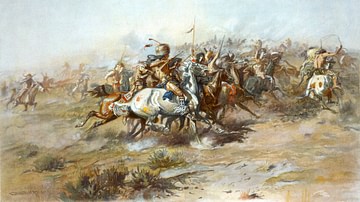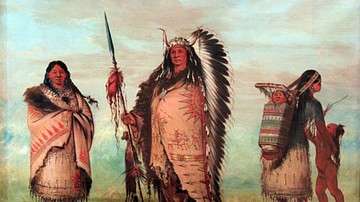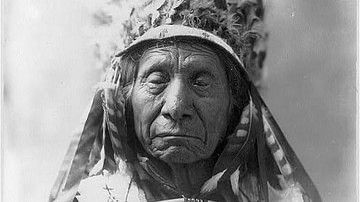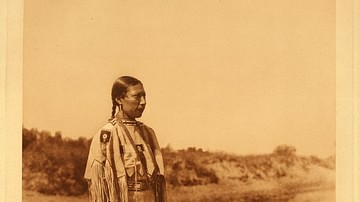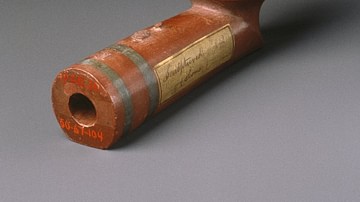The Lakota Sioux, like other tribal nations, had many versions of a creation story but all involved Wakan Tanka (Great Mystery or Great Spirit), the supreme creative power in the universe, who made all things and so caused all to be related as a family, whether human, animal, plant, spirit, or element; one's 'relatives' were all living things.
Since everything had been born from the same source, all things were imbued with the same sacred spirit, including what one might call inanimate objects such as stones, trees, mountains, and earth. Human beings were only one part of the great, intricate, web of creation; neither superior nor inferior to any other, whether a bear or elk or an ant or rock. Scholar Larry J. Zimmerman writes:
Most Native American origin stories give people no more power than the other parts of creation; people are the Earth's partners and know it intimately as the source from which they sprang. The lands on which Indians live reflect the creation and there is a rich body of stories that detail how things came to be. (76)
Two of the best-known Lakota creation tales are the one where Wakan Tanka creates the first world directly beginning with rock (a world later destroyed by fire) and the one where animals are enlisted as helpers in bringing up primordial mud from the deep waters after Wakan Tanka has destroyed the second world through a flood. The world in which the Native Americans were living at the time of the European conquest of North America was understood as the third world which, Wakan Tanka warned, would also be destroyed if people did not behave properly with respect for all living things.
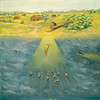
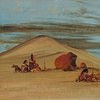
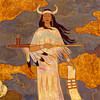
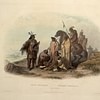

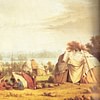
Twelve Stories of the Plains Indians
Sioux Creation Stories
There are no dates attached to either creation story as they were passed down generation-to-generation orally for many years, possibly thousands of years, through the storytellers who were entrusted to remember and relate the sacred tales that informed the culture of the Sioux. The first record of the stories comes from the 19th century when American explorers like George Catlin (l. 1796-1872) recorded them. The stories also have no titles but are usually referenced as "Sioux Creation Myth" or "Sioux Creation Story" without specifying which of the many versions is being related. There is also no way of knowing whether the story involving Wakan Tanka and the earliest gods (beginning with rock) is the story of the creation of the first world or of the second that is then destroyed by a great flood.
In the story where Wakan Tanka creates the world directly, nothing exists but darkness (described as "the Black of Darkness"), an aspect of Wakan Tanka known as Han. Wakan Tanka sent his spirit to inhabit a place within Han, and this became Inyan (Rock) and so rock existed within endless darkness. Wakan Tanka wanted to expand his creation and so made Maka (Earth) from his blood and then Skan (sky). There were now four primordial gods – Han, Inyan, Maka, and Skan – all aspects of Wakan Tanka but able to operate independently for their own purposes.
Skan drew on Han's deep darkness to create the darkness people know as 'night' and then drew on himself, Maka, and Inyan to create Wi (the sun), who gave light and warmth to the other gods. These gods then wanted something to share the light and warmth with and were lonely by themselves and so created the four winds of the world, the whirlwind, humans, and buffalo. The bear, who could walk on two legs, was created at the same time as the two-legged humans and was considered their brother. The four-legged creatures were created at the same time as the buffalo and were also spiritual brethren.
The creative act also gave birth to the spiritual power of all things individually and collectively (Sicun), the breath of life (Niya) as well as ghosts and one's "astral self" (Nagi) and the divine essence (Nagila, "little ghost") that animates all things and allows one to recognize that same divine energy in other people, animals, and all of creation. Once these energies were active, the gods rested, and the created world was begun.

If this story is understood as the creation of the first world, then humans eventually lost touch with their Nagila, failed to recognize the sacred in each other and their fellow participants in the great dance of the universe, and were destroyed by Wakan Tanka in a great fire. Wakan Tanka then created the second world, but, in time, the human beings forgot themselves again and began to behave badly, and so this world was destroyed by a great flood. The second Sioux creation story, given below, describes how Wakan Tanka then created the third world, the world of this present era, and also explains why the world (or North America at least) was called "Turtle Island" – because it was formed on the back of the turtle.
Text
The following text dates from c. 1910 but is understood to be much earlier and carries the vague date of "pre-18th century" on the site Native American Creation Stories. The same story in abridged form appears on the site First People as Lakota Creation Myth. In the following version, an aspect of the Great Flood story from the Bible (Genesis 6-9) appears when Wakan Tanka places a rainbow in the sky as a sign there will be no more flood, just as God does in Genesis 9:12-17 when the waters have subsided and Noah and his family are allowed to leave the ark.
This is understood as an example of syncretism of religious beliefs caused by the introduction of Christianity to Sioux culture. The Native American Church, epitomizing such syncretism, was well established by the late 19th century, and so it is not surprising to find literary borrowing from the Bible in a Sioux tale. Whether the rainbow featured in the original Lakota Sioux story is unknown.
There was a world before this world, but the people in it did not know how to behave themselves or how to act human. The Creating Power was not pleased with that earlier world. He said to himself: "I will make a new world." He had the pipe bag and the chief pipe, which he put on the pipe rack that he had made in the sacred manner. He took four dry buffalo chips, placed three of them under the three sticks, and saved the fourth one to light the pipe.
The Creating Power said to himself: "I will sing three songs, which will bring a heavy rain. Then I'll sing a fourth song and stamp four times on the earth, and the earth will crack wide open. Water will come out of the cracks and cover the land." When he sang the first song, it started to rain. When he sang the second, it poured. When he sang the third, the rain-swollen rivers overflowed their beds. But when he sang the fourth song and stamped on the earth, it split open in many places like a shattered gourd, and water flowed from the cracks until it covered everything.
The Creating Power floated on the sacred pipe and on his huge pipe bag. He let himself be carried by waves and wind this way and that, drifting for a long time. At last, the rain stopped, and by then all the people and animals had drowned. Only Kangi, the crow, survived, though it had no place to rest and was very tired. Flying above the pipe, "Tunkasllila, Grandfather, I must rest soon"; and three times the crow asked him to make a place for it to light.
The Creating Power thought: "It's time to unwrap the pipe and open the pipe bag." The wrapping and the bag contained all manner of animals and birds, from which he selected four animals known for their ability to stay under water for a long time. First he sang a song and took the loon out of the bag. He commanded the loon to dive and bring up a lump of mud. The loon did dive, but it brought up nothing. "I dived and dived but couldn't reach bottom," the loon said. "I almost died. The water is too deep."
The Creating Power sang a second song and took the otter out of the bag. He ordered the otter to dive and bring up some mud. The sleek otter at once dived into the water, using its strong webbed feet to go down, down, down. It was submerged for a long time, but when it finally came to the surface, it brought nothing.
Taking the beaver out of the pipe's wrapping, the Creating Power sang a third song. He commanded the beaver to go down deep below the water and bring some mud. The beaver thrust itself into the water, using its great flat tail to propel itself downward. It stayed under water longer than the others, but when it finally came up again, it too brought nothing.
At last, the Creating Power sang the fourth song and took the turtle out of the bag. The turtle is very strong. Among our people it stands for long life and endurance and the power to survive. A turtle heart is great medicine, for it keeps on beating a long time after the turtle is dead. "You must bring the mud," the Creating Power told the turtle. It dove into the water and stayed below so long that the other three animals shouted: "The turtle is dead; it will never come up again!"
All the time, the crow was flying around and begging for a place to light.
After what seemed to be eons, the turtle broke the surface of the water and paddled to the Creating Power. "I got to the bottom!" the turtle cried. "I brought some earth!" And sure enough, its feet and claws—even the space in the cracks on its sides between its upper and lower shell—were filled with mud.
Scooping mud from the turtle's feet and sides, the Creating Power began to sing. He sang all the while that he shaped the mud in his hands and spread it on the water to make a spot of dry land for himself. When he had sung the fourth song, there was enough land for the Creating Power and for the crow.
"Come down and rest," said the Creating Power to the crow, and the bird was glad to.
Then the Creating Power took from his bag two long wing feathers of the eagle. He waved them over his plot of ground and commanded it to spread until it covered everything. Soon all the water was replaced by earth. "Water without earth is not good," thought the Creating Power, "but land without water is not good either." Feeling pity for the land, he wept for the earth and the creatures he would put upon it, and his tears became oceans, streams, and lakes. "That's better," he thought.
Out of his pipe bag the Creating Power took all kinds of animals, birds, plants and scattered them over the land. When he stamped on the earth, they all came alive.
From the earth the Creating Power formed the shapes of men and women. He used red earth and white earth, black earth and yellow earth, and made as many as he thought would do for a start. He stamped on the earth and the shapes came alive, each taking the color of the earth out of which it was made. The Creating Power gave all of them understanding and speech and told them what tribes they belonged to.
The Creating Power said to them: "The first world I made was bad; the creatures on it were bad. So I burned it up. The second world I made was bad too, so I drowned it. This is the third world I have made. Look: I have created a rainbow for you as a sign that there will be no more Great Flood. Whenever you see a rainbow, you will know that it has stopped raining."
The Creating Power continued: "Now, if you have learned how to behave like human beings and how to live in peace with each other and with the other living things—the two-legged, the four-legged, the man-legged, the fliers, the no-legs, the green plants of this universe—then all will be well. But if you make this world bad and ugly, then I will destroy this world too. It's up to you."
The Creating Power gave the people the pipe. "Live by it," he said. He named this land the Turtle Continent because it was there that the turtle came up with the mud out of which the third world was made.
"Someday there might be a fourth world," the Creating Power thought. Then he rested.
Conclusion
The story features several elements from Sioux ritual including the use of the ceremonial pipe in ritual, sacred tobacco held in a special bundle, the power of song in creation, and the depiction of animals as vital co-workers in the cycle of existence. Wakan Tanka first creates land on the back of the turtle, then water, then animals, birds, and plants, and only then are humans created; suggesting, perhaps, that human beings should not think more highly of themselves than of all that was created before them. Zimmerman comments:
Some Native peoples believe that animals created the world. For many, the creator was an earth-diver, a turtle or other small creature, which brought up mud from the depths of the primeval waters and fashioned land from it…In Native belief, animals have spirits and enjoy a complex reciprocal relationship with people, plants, and the earth. Animals often play an important role in teaching people how to behave. (85)
In the story, the loon, otter, and beaver all do their best to bring Wakan Tanka the mud necessary for the creation of land (the loon even says, "I almost died") and, in doing so, honor the Creator and the creation. The turtle, considered especially sacred by the Sioux, accomplishes the mission by filling its shell with mud, something the other animals were not equipped to do, highlighting a central Sioux belief that each living thing had its own unique purpose to fulfill – human, animal, plant, or stone – and everyone's participation was necessary, no matter how small they might seem, in the wonder of the creation.
At the end of the story, Wakan Tanka gives the people the ceremonial pipe and a Sioux audience would have understood this to mean he was also giving them the seven sacred rituals that informed their spiritual beliefs and traditions. The conclusion of the story echoes the words of White Buffalo Calf Woman, the intermediary between the people and Wakan Tanka, that they will endure and prosper as long as they remember and honor their creator and creation through the Sioux ceremonial pipe and seven sacred rituals.
The rainbow, in this story, only serves as a reminder that it has stopped raining while, in the biblical tale, it is set as a sign of the promise that God will not destroy humanity again. The Sioux creation story makes no such promise, however, ending with the possibility of the destruction of the present third world if people again forget what they owe to their Creator, each other, the animals, and Earth as everyone's collective home.

